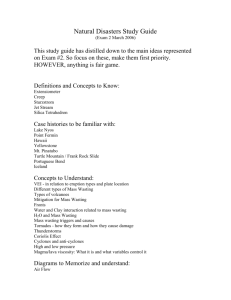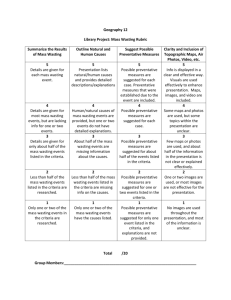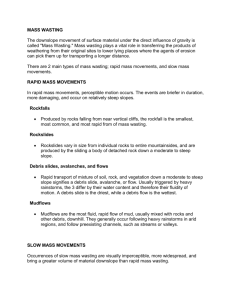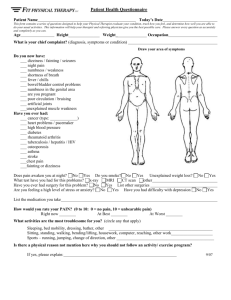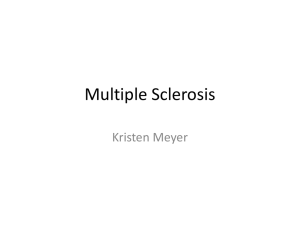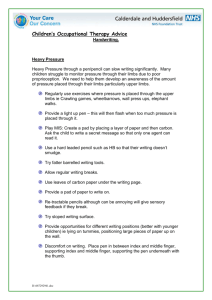Title: Syringomylia affecting ADLs Author: Islam SMA, MD, Resident
advertisement
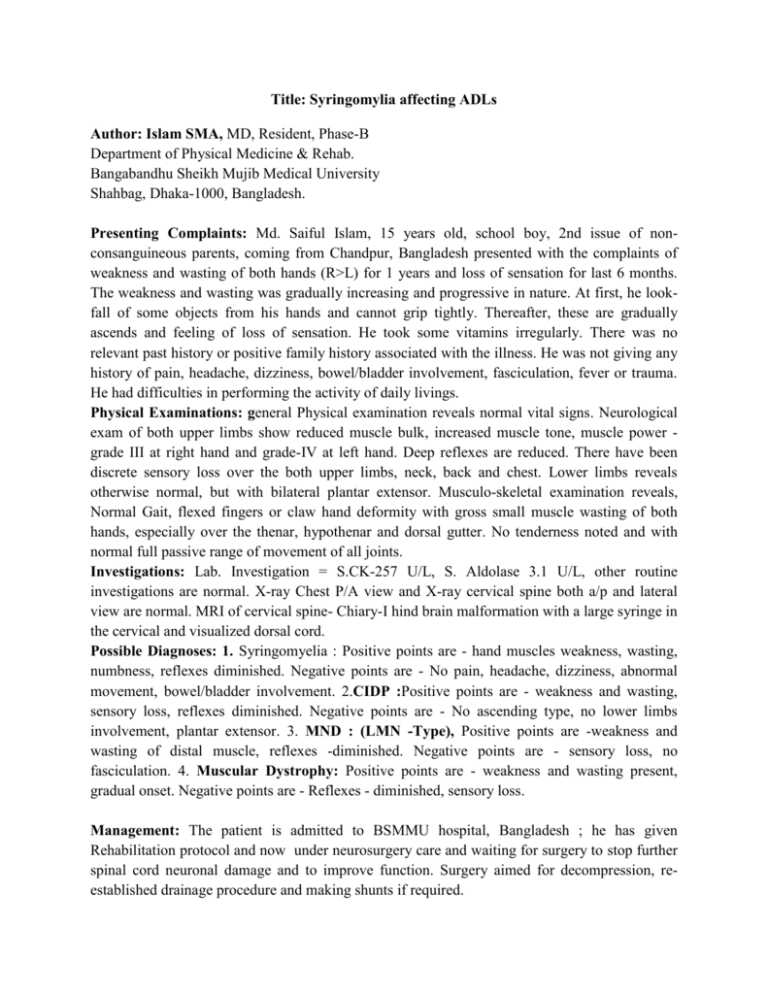
Title: Syringomylia affecting ADLs Author: Islam SMA, MD, Resident, Phase-B Department of Physical Medicine & Rehab. Bangabandhu Sheikh Mujib Medical University Shahbag, Dhaka-1000, Bangladesh. Presenting Complaints: Md. Saiful Islam, 15 years old, school boy, 2nd issue of nonconsanguineous parents, coming from Chandpur, Bangladesh presented with the complaints of weakness and wasting of both hands (R>L) for 1 years and loss of sensation for last 6 months. The weakness and wasting was gradually increasing and progressive in nature. At first, he lookfall of some objects from his hands and cannot grip tightly. Thereafter, these are gradually ascends and feeling of loss of sensation. He took some vitamins irregularly. There was no relevant past history or positive family history associated with the illness. He was not giving any history of pain, headache, dizziness, bowel/bladder involvement, fasciculation, fever or trauma. He had difficulties in performing the activity of daily livings. Physical Examinations: general Physical examination reveals normal vital signs. Neurological exam of both upper limbs show reduced muscle bulk, increased muscle tone, muscle power grade III at right hand and grade-IV at left hand. Deep reflexes are reduced. There have been discrete sensory loss over the both upper limbs, neck, back and chest. Lower limbs reveals otherwise normal, but with bilateral plantar extensor. Musculo-skeletal examination reveals, Normal Gait, flexed fingers or claw hand deformity with gross small muscle wasting of both hands, especially over the thenar, hypothenar and dorsal gutter. No tenderness noted and with normal full passive range of movement of all joints. Investigations: Lab. Investigation = S.CK-257 U/L, S. Aldolase 3.1 U/L, other routine investigations are normal. X-ray Chest P/A view and X-ray cervical spine both a/p and lateral view are normal. MRI of cervical spine- Chiary-I hind brain malformation with a large syringe in the cervical and visualized dorsal cord. Possible Diagnoses: 1. Syringomyelia : Positive points are - hand muscles weakness, wasting, numbness, reflexes diminished. Negative points are - No pain, headache, dizziness, abnormal movement, bowel/bladder involvement. 2.CIDP :Positive points are - weakness and wasting, sensory loss, reflexes diminished. Negative points are - No ascending type, no lower limbs involvement, plantar extensor. 3. MND : (LMN -Type), Positive points are -weakness and wasting of distal muscle, reflexes -diminished. Negative points are - sensory loss, no fasciculation. 4. Muscular Dystrophy: Positive points are - weakness and wasting present, gradual onset. Negative points are - Reflexes - diminished, sensory loss. Management: The patient is admitted to BSMMU hospital, Bangladesh ; he has given Rehabilitation protocol and now under neurosurgery care and waiting for surgery to stop further spinal cord neuronal damage and to improve function. Surgery aimed for decompression, reestablished drainage procedure and making shunts if required. Discussion: This case presented does not have a typical uniform presentation. The patient only presents weakness and wasting of both hands with dissociated sensory loss of both upper limbs. There was no history of local pain or headache, dizziness or un-co-ordinated movements. Brain stem signs are common is syringomyelia associated with chiary malformations, which remains absent in the present study case. There has been no lower limbs involvement. Hand muscle weakness and wasting can be present with various other conditions as well; and we tried to exclude other possibilities. Conclusion: There is no known way so far to prevent this condition, other than avoiding injury to the spinal cord. This slowly progressing condition over time cause severe disability. Syringomyelia is not a rare case at PMR setting, but it needs a uniform protocol to manage the long term patient. Potential implications: Reporting and discussion Next steps: Recommendation of rehabilitation and other management protocol Acknowledgements and disclaimers: I, am Dr. Atiqul Islam as submitting author for this abstract take full responsibility for its integrity and ethical conduct. I certify that each of the co-authors listed has reviewed this document and approves its submission with their name as listed in the order listed. I certify that each of the co-authors has agreed that this form lists any pertinent conflict of interest issues pertaining to their participation in the described program. My authors and I agree that, should this abstract be accepted for this meeting, the International Rehabilitation Form has our permission to store, reproduce, distribute, and otherwise use the abstract and any presentation we may make; including audio, video, and other media; in any form or format. Full publications of accepted abstracts must acknowledge first presentation at this meeting.
